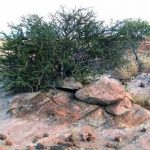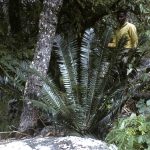TREE LIFE
OCTOBER 1992
MASHONALAND CALENDAR
Tuesday 6thOctober : Botanic Garden Walk. Park at the Herbarium where we will meet Tom Muller at 1700 hours.
Sunday 18th October : Gosha Park – Peterhouse Conservation Area Marondera
Anyone lucky enough to have back numbers of Tree Life can read an account in No.68 of October 1985 by Phil Haxen’s report entitled “Outing to Peterhouse Conservation Project Gosha Park.” That seemed to be a day for 3s – 3 Cussonia species, 3 Protea species, 3 Erythrina species and probably 3 Diospyros, as well as specials like Olinia vangueriodes and Apodites dimidiate, and I recall on a subsequent visit masses of the very pretty Tuneas in flower. It will be interesting to see how the park has developed since then and perhaps Phil will explain the concept of the plastic dam.
Saturday 24th October : Walk with Mark In the Mukuvisi Woodlands. Meet at the Paget Road entrance at the comer of Paget Road and Inyanga Crescent. There will be someone to guard the cars.
Tuesday 3rd November : Botanic Garden Walk.
MATABELELAND CALENDAR
Sunday 4th October : A visit to a wonderful indigenous tree nursery run by the Williams‘ at Turk Mine. An opportunity to see green leaves in October. This will be a half day visit so bring chains and tea. Rendezvous at the City Hall car park for an 8.30 am departure.
Monday 12th October : ‘The Urban Trail‘ Meet at Hillside Dams at 1700 hours
Sunday 1st November : All day visit in the Matopos. Before lunch we will follow The Gun Carriage Route from Lower Outspan to the Grave, and in the afternoon we will botanize in the Whitewaters area. Rendezvous at Retreat Shopping center for the usual 8.30 am departure.
KHAMI RUINS 2 WEDNESDAY 12 AUGUST 1992
Since visiting Regina Ruins and having read Rob Burrett’s article on the association of the tree species with ruin sites, Khami has been much on our minds. Wednesday’s public holiday was just too good an opportunity to miss, so we collected our hats, a tree card, put the dog in the car and headed west.
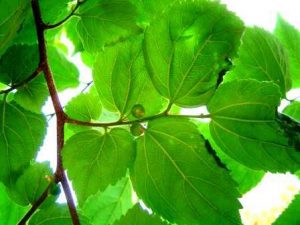
Celtis africana. Photo: Bart Wursten. Source: Flora of Zimbabwe
The Barrett hypothesis has much to commend it and certainly our visits to the Bozwi sites on the East of the central watershed (Regina, Bila and Nalatale) confirm his observations to the point that a particular species is often associated with a particular ruin, for example — Nalatalo and Cussonia spicata, Bila and Celtis africana and Regina with Euphorbia ingens.
Khami to the west of the watershed seems to be the exception. Amongst the enclosures and in the acropolis area Commiphora mollis, Sclerocarya birrea and Papea capensis dominate the upper storey. Yes we did see Erythrirna latissima and Cussonia natalensis but no Celtis africana (difficult to pick up at this leafless time of the year, but its bark is a give away), and only two youngish Euphorbia ingens. Certainly the patterns and combinations at Khami seen, from an initial recce rather different. Another visit is a must.
-IAN McCAUSLAND
And something of interest from The Economist July 25 1992
Wall flowers : From stone circles to stately homes, old walls are the stuff of History. If Oliver Gilbert has his way, they will soon be the stuff of botany as well. Many plants find walls congenial places on which to live. Lichens spread luxuriantly across their surfaces, ferns cower in shaded mortar and crevices abound with stone crops. But according to Dr Gilbert, a botanist at Sheffield University, plant-rich walls are more than just a cheering and colourful sight. They are also a refuge for species whose natural habitats are disappearing. A score of British plants, including such rarities as yellow whitlow grass and wall bedstraw, are-now found mainly on walls.
Castle walls can be particularly rich. They have had plenty of time to develop interesting floras and they usually have a lot of crevices and a range of elevations from shade to full sun. Old city walls are also good rockeries. Tenby, in Wales, has 42 species per kilometre of its medieval wall. Conway, also in Wales, weighs in with 29 per km. Meanwhile in England, York can manage only 18 per km.
Plants from arid habitats do particularly well on walls. Oxford ragwort, for instance, normally lives on some slopes in Central Europe. It established itself on Oxford’s walls in the late 18th century after escaping from the university’s botanic gardens, and has subsequently spread across much of Britain. Manv Mediterranean herbs, which first found their way to England with medieval monks, have also naturalised themselves on walls. The monastic physic gardens where they grew may have disappeared, but the garden walls often linger. The mined nunnery walls at Godstow in Oxfordshire hold birthwort, once used in midwifery. Hyssop and winter savory still flower in the old physic garden in Beaulieu in Hampshire.
Though the type of rock from which a wall is built is important for things like lichens and mosses, the key for many plants is not what the wall is made of, but what sort of mortar is holding it together. Lime mortar – used until about 1870 – was soft and weathered quickly. Plants soon get a foothold. Modern cement mortar is harder. It can take up to 80 years before roots can penetrate it, although in the moister parts of Britain the softening can be much quicker.
Wall maintenance, or the lack of it, can also make a difference. A survey in Central France found the most luxuriant growths on Protestant churches – less used, and therefore less well-maintained, than their barer Catholic counterparts.
Lime-mortared walls are now themselves an endangered species. Either they have fallen, or all of the mortar has crumbled away, or they have been re-pointed with cement. This is where plant conservationists and maintenance engineers do not always see eye to eye. Though some plants can prise the stones apart, a greener public is starting to demand greener walls. Plans to “clean” the walls of Fountains Abbey, a World Heritage Site in North Yorkshire, met with fierce opposition, the common pink growing on than was part of the reason. Human history may be rooted in stone. So are many plants.
BOTANIC GARDEN WALK : 1 SEPTEMBER 1992
At the start of the walk it was agreed that we would not tackle a specific group of plants but would walk through the Gardens and Tom would talk about anything of interest which was seen. This approach was very successful and a great deal of interest was seen.
Our first port of call was at a low shrub we had seen on an earlier walk. Although it’s bipinnate leaves were supposed to be sensitive, patting the leaves produced no reaction.
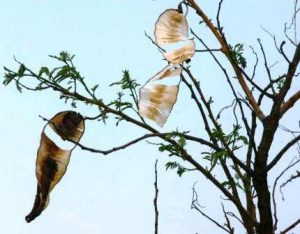
Entada abyssinica. Photo: Bart Wursten. Source: Flora of Zimbabwe
The pods had bristly brown segments which fall out, leaving the empty margin of the pod, in a similar manner to Entada abyssinica. It was Mimosa pigra; a species from the subfamily of the LEGUMINOSAE, the MIMOSOIDEAE. In Zimbabwe, it grows by rivers in the northern and north-western districts. It was suggested that the species might not be native, as Mimosa is predominantly an American genus.
On to Balanites maughamii, where Tom showed us the forked spines and leaves in pairs.
This species is an evergreen shrub. It is said that the fruits germinate better if they have been through an elephant. The other Balanites, B. aegyptica is characteristic of mopane woodland and has simple thorns.
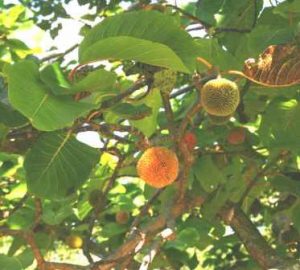
Burttdavya nyasica. Photo: Bart Wursten. Source: Flora of Zimbabwe
We next spent some time at Burttdavya nyasica a medium-sized tree from the family
RUBIACEAE. It has large broad thick leaves but there was no sign of the usual stipules (had they fallen off?). Its flowers occur in “balls” like Breonadia salicina. Tom demonstrated how they are mushy inside and smell of honey. This species grows naturally in Mozambique and Malawi in low-altitude forest.
Joseph Burtt Davy in his “Flowering Plants and Ferns of the Transvaal” refers to Acacia detinens. The specific name means “detaining”‘ and he writes as follows: “Burchell gave it this name ‘in revenge‘ for the ill-treatment given by this bush, which caught his clothes and hat in such a way that he was only extricated without tearing his clothes with the help of two natives who cut off the branches”.
Now known as Acacia mellifera subsp. detinens, a bush in the Gardens was coming into flower. Its thorns are curved but its flowers were in spherical clusters, thereby apparently breaking the normal rule. This was a puzzle for some of us, to whom the species was new. Perhaps the explanation is that the spherical clusters are actually slightly elongated so that the rule is not so much broken as stretched.
A spectacular tree flowering in the Gardens was Fernandoa magnifica. We picked some flowers from the lower branches – these were red with a yellow center and showed a similarity with Kigelia. Tom mentioned that this is a very rare plant in Zimbabwe, occurring only in one or two places in the Save Valley, but is common on the Mozambique coast.
Four species of Sterculia were shown to us. One, S. rogersii, was just in flower. Tom showed how similar the flowers are to Brachychiton, various species of which are commonly planted around Harare. Another species examined was Sterculia appendiculata, a very rare tree in Zimbabwe, occurring in the Pfungwe reserve. Although apparently growing well, no Flowers or fruits have yet been produced in the Gardens.
Wherever we went in the Gardens, we came across the ravages of Armillaria, the honey-fungus. A large number of trees have been lost from this cause.
Once again, our thanks to Tom for another very stimulating session in the Botanic Gardens.
–Mark Hyde
SUNDAY, 20TH SEPTEMBER, 1992
About 84 people gathered at Kilmaodaugh, Lance Perry’s farm on the Dyke, and with no tea and cake to distract us or delay our start, we began with a very informative talk by Rob Barrett who clearly and in simple terms (with a few cratons and lopolyths thrown in) outlined the formation of the Dyke. From a botanical point of view, we learnt that it is composed of two main rock types (1) serpentine containing high percentages of metals such as nickel and chromium which are toxic to many species, but where one finds a number of endemics* such as Rhus wildii, Aloe ortholopha and Ozoroa longepetiolata. Here there are also species tolerant of the serpentine-derived soil eg Diplorhynchus condylocarpon and Rhus tenuipes – (2), pyroxenite containing high magnesium levels and iron oxide but which is more fertile, supporting a high diversity of species. This is usually found running along the top of the dyke with parallel bands of serpentine on either side. Since we were to “tree” on the more fertile area we did not expect to see serpentine endemics, but on the drive to our meeting place, we crossed the serpentine and were able to spot Oxoroa longepetiolata (Great Dyke raisin-berry) with its drooping, silvery leaves. As its specific name implies it has a much longer petiole than O.insignis which we saw later, and has conspicuously silvery, silky hairs under leaf.
*ENDEMIC – botanically this applies to a species confined to a particular area and not indigenous elsewhere.
We were very fortunate to have with us, George Hall (our Chairman), Phil Haxen (restored to us after a Scandinavian holiday) and Bob Drummond (a delightful surprise) to lead us in three main groups.
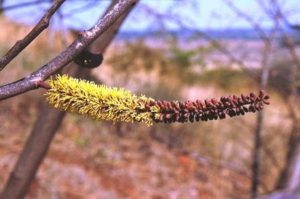
Elephantorrhiza geotzei. Photo: Mark Hyde. Source: Flora of Zimbabwe
The most noticeable feature here and on the drive-in was the colour; heart-lifting in this time of drought. The msasas were outstanding in their new leaf – some trees from afar looking as if they were covered in deep red blossom: here too the wine red of Flacourtia indica, Faurea speciosa and F. saligna and the harlequin red and green yellow flower spikes of Lannea discolor, the small, clustered yellow flowers of Turrea nilotica and the long purple plumes of Elephantorrhiza goetzei about to bust into yellow blossom. Several of the Bequertiodendron magalismontanum bore flowers, these clustered in small brownish-pink groups directly on the trunk and branches, the term for which, Benedicta Graves tells us in one of her articles, is cauliflory (Caulis = stalk). Spring has quite definitely sprung, although the heat was high summer and had us drinking deeply and gratefully on our return to the cars at lunchtime — but I’ve jumped ahead! Before that we found many Gardenia ternifolia, rough on both sides of the leaf when licked; Strychnos innocua with its smooth “powder rubbing” bark, and perhaps most exciting, Olax obtusifolia in great abundance here as small shrubs. This is not a tree we see much of on our outings, so it was a good opportunity to “get our eye in” and learn to recognize the plasticky feeling leaves ranked alternately on either side of the branches. The leaves are brittle when crushed, but as yet I have not managed to get from then the bitter-almond smell of cyanide that we are told of. Among the granite rocks were Schrebera alata, Apodytes dimidiata, Commiphora marlothii (yielding paper to be written on), Euphorbia griseola, Euclea natalensis which in some cases we found difficult to distinguish from Diospyros kirkii everywhere, tall, graceful Brachystegia glaucescens.
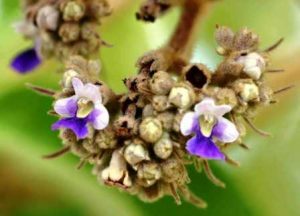
Vitex payos. Photo: Bart Wursten. Source: Flora of Zimbabwe
It was a great pleasure to have had Bob Drummond with us for his company and expertise and because, as George said, his presence made a Monday morning trip to the Herbarium with our specimens unnecessary, since he could answer our queries on the spot. Such was the case with some spikes of white and blue flowers. Vitex payos had been considered, but Bob suggested we rub the branch below the flowers and smell – definitely a Cleredendron pong. It was C. wildii but the Vitex payos query could be excused as both are members of the VERBENACEAE family with similar flowers.
Lunch was enjoyed in numerous far-flung islands of shade making hot work for Andy as he tracked us all down to sign the register. We were joined by members of the Aloe Society at this point and together, after lunch, climbed the steel ox wagon track to the site of the Eyre brothers’ house and store to have a talk by Rob Burrett on their history. Eyre was among the first true pioneers and his farm, 1892, the first in Lomagundi to be “beaconed” although not registered for several more years. His story and that of his brother Herbert, who joined him, was short and tragic, seven years in which they farmed, ran the store and both died. Herbert was killed in 1896 during the Mashona uprising and Arthur died of blackwater fever a week before his wedding in 1899. The pass through the Dyke, Airey’s Pass is mis-spelled and Rob says will be corrected in the next edition of the map.
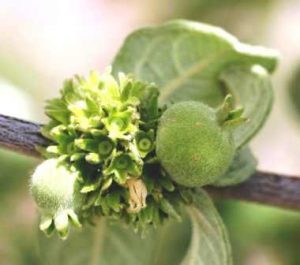
Tapiphyllum velutinum. Photo: Bart Wursten. Source: Flora of Zimbabwe
A tour of the old homestead ruins and surrounds added to our list Catunaregum spinosa, Cassine matabelica, Dalbergia nitidula and a Kirkia acuminata among others. It was then down the hill to the cars and our individual ways home. Ours took us past the river where we found Myrica serrata and Salix mucronata and then on via Caesar’s Mine with a beautiful drive through the Dyke and a view of a paraglider lazily wafting in company with an Augur Buzzard.
Maureen’s official list totalled 82 and included Olea europaea and Rapanea melanophoeos, two more riverine species, as well as Ximenia caffra and X. americana, Garcinia buchananii, Tapiphyllum velutinum and Pittosporum viridiflorum.
Our thanks to Lance Perry for having us at Kilmacdaugh, Tree Society members have been his guests on several occasions and it is always an excitingly different venue. Thanks too, to Rob whose talks, geological and historical, set the scene for us and added greatly to the enjoyment of the day.
This was the last outing for the Berendts who return to Sweden next month- may we wish them bon voyage and happy treeing in their northern forests.
-George Hall
SEASONS IN ZIMBABWE – Acknowledged with thanks to The Hartebeeste No. 21 and to Kim Damstra.
Are we confusing our children with illogical dogma? The evening fireplace is most inviting in the coldest month, July. Is this Winter? It is only in august that the Msasa (Brachystegia spiciformis) and Munondo (Julbernardia globiflora) lose their leaves. Combined with swirling winds, this is the best approximation of Fall. In late August, the trees stand bare, so Winter has returned. By mid-September, the trees flush out in brilliant scarlet and rich burgundy, all the glory of Autumn colours. These soon change to fresh green and Spring has arrived with many indigenous trees in full flower. The October heat and afternoons by the pool provide a vision of Summer. But, for a young Zimbabwean the closest picture book vision of Mid-Winter occurs in December when shop windows are draped in cotton wool. Before the cards with snowy images are cleared away it is back to the pool and summer sunshine. Instead of four seasons there appear to be eight, and this in only six months. Obviously a host of questions need to be answered.
Why do the leaves fall after the coldest month has past?
In temperate climates, trees drop their leaves in preparation for a drought. This is not due to a lack of water as the soil may be wet and the ground covered with snow. The drought is physiological, at sub-zero temperatures the solid water is unavailable to plants. Zimbabwean trees drop their leaves in response to a physical drought. Leaves lose water so fewer leaves means less water loss. During the coldest months evaporation is low so drought is less severe.
In temperate regions there is a direct relationship between temperature, bare trees and hibernating animals. This is Winter. In Zimbabwe the concept of hibernation presents another problem. For example, the bull frog (Pyxicephalus adspersus) burrows underground at the end of the rains. It soon becomes surrounded by layers of dead skin that seal the eyes, mouth and cloaca, only the nostrils remain open. The bull frog remains in this cocoon until the start of the rains in November. As this activity is not related to cold temperatures it cannot be called hibernation. The correct term is retraherance, which means, assistance of an unfavourable condition, in this case drought.
Why do young leaves flush out red?
In Autumn trees prepare to drop their leaves by extracting many of the minerals and nutrients that can be recycled. The green chlorophyll is broken down and this may expose other colours that have been present in the leaf all along. To understand the red flush and new leaves we need to understand the relationship between molecules and light energy.
Molecules are composed of atoms joined together by a range of different bonds. The bonds may be single or multiple. The multiple bonds often have a natural vibration. If this vibration is the same frequency as a particular wavelength of light then this bond will absorb that wavelength and use its energy to vibrate. Each wavelength corresponds to a particular colour. When a molecule absorbs a particular wavelength the colour we see is the complementary colour. Complementary colours lie opposite each other on the colour wheel. To construct a colour wheel, write down the three primary colours, red, blue and yellow, in a triangle. Between each pair of colours record the colour that results from mixing paints of these colours, red and blue make purple, blue and yellow make green, yellow and red make orange. These are the three secondary colours of the primary colour and colour wheel. A pair of complementary colours consist of the primary colour and the secondary colour that lie opposite each other on the colour wheel – red and green, blue and orange, yellow and purple. These are strong combinations that are widely used in art and advertising to create striking effects.
The chlorophyll molecule in leaves absorbs red light. The plant uses the energy trapped in this way to make sugars. Because the red is absorbed, the leaf appears to be the complementary colour which is green.
Plants cannot use green light, they reflect it. Therefore, a greenhouse constructed with green glass is a death trap for plants, they may as well be kept in a dark cupboard.
Under high light intensities too much red light may shine on a leaf. Some plants produce a natural screen that protects the chlorophyll molecules, this is a red water-soluble pigment called anthocyanin. Many succulent plants have red leaves when they are grown in full sunlight. The same red pigment protects some young leaves as they flush out. When the leaf expands and hardens, this protection is less important and the colour changes to green.
All this indicates that our terminology is inappropriate. We do not have an Autumn or a Winter. There are two obvious seasons which each have Shona names, Zhizha the wet season and Chirimo, the dry season. The dry season is long and can be divided into the cool-dry season and the hot dry season. It is a great pity that in all the years in which English has been spoken in Zimbabwe, terms that describe the seasons have not become part of the vocabulary. It is still not too late. Kim Damstra
And finally a reminder to collect seed for Tom Muller and the Botanic Garden. Maureen can send you a list. Just a word of warning – it is an offence to pick or remove anything from National Parks, if caught there is a stiff fine.
-Kim Damstra
GEORGE HALL CHAIRMAN


